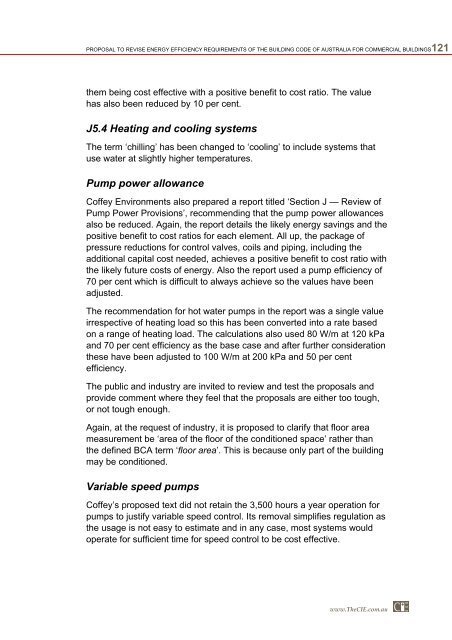PDF | 2 MB - Australian Building Codes Board
PDF | 2 MB - Australian Building Codes Board
PDF | 2 MB - Australian Building Codes Board
You also want an ePaper? Increase the reach of your titles
YUMPU automatically turns print PDFs into web optimized ePapers that Google loves.
PROPOSAL TO REVISE ENERGY EFFICIENCY REQUIREMENTS OF THE BUILDING CODE OF AUSTRALIA FOR COMMERCIAL BUILDINGS 121<br />
them being cost effective with a positive benefit to cost ratio. The value<br />
has also been reduced by 10 per cent.<br />
J5.4 Heating and cooling systems<br />
The term ‘chilling’ has been changed to ‘cooling’ to include systems that<br />
use water at slightly higher temperatures.<br />
Pump power allowance<br />
Coffey Environments also prepared a report titled ‘Section J — Review of<br />
Pump Power Provisions’, recommending that the pump power allowances<br />
also be reduced. Again, the report details the likely energy savings and the<br />
positive benefit to cost ratios for each element. All up, the package of<br />
pressure reductions for control valves, coils and piping, including the<br />
additional capital cost needed, achieves a positive benefit to cost ratio with<br />
the likely future costs of energy. Also the report used a pump efficiency of<br />
70 per cent which is difficult to always achieve so the values have been<br />
adjusted.<br />
The recommendation for hot water pumps in the report was a single value<br />
irrespective of heating load so this has been converted into a rate based<br />
on a range of heating load. The calculations also used 80 W/m at 120 kPa<br />
and 70 per cent efficiency as the base case and after further consideration<br />
these have been adjusted to 100 W/m at 200 kPa and 50 per cent<br />
efficiency.<br />
The public and industry are invited to review and test the proposals and<br />
provide comment where they feel that the proposals are either too tough,<br />
or not tough enough.<br />
Again, at the request of industry, it is proposed to clarify that floor area<br />
measurement be ‘area of the floor of the conditioned space’ rather than<br />
the defined BCA term ‘floor area’. This is because only part of the building<br />
may be conditioned.<br />
Variable speed pumps<br />
Coffey’s proposed text did not retain the 3,500 hours a year operation for<br />
pumps to justify variable speed control. Its removal simplifies regulation as<br />
the usage is not easy to estimate and in any case, most systems would<br />
operate for sufficient time for speed control to be cost effective.<br />
www.TheCIE.com.au
















